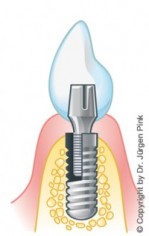
Construction of a dental implant
Missing teeth can be replaced by implants. They are embedded into the bone and serve as an artificial dental root. Once the implant has healed, the implant receives the so-called supra construction. This means that depending on the circumstances, a crown, bridge, or a removable dental prosthesis is placed on top of the implant. In order to create the artificial root, a titanium pin is used because this metal does not cause unwanted side-effects such as allergies. Titanium is a long-lasting metal and can withstand a lot of pressure which occurs when chewing. Implants can
be inserted under local anaesthesia. If regularly checked-up on and with an optimal care these implants achieve excellent treatment successes and can serve their function for a life-time.
1. THE ADVANTAGES OF A DENTAL IMPLANT:
Dental implants are considered to be the best functional and aesthetic alternative as a dental
prosthesis and offer the following advantages:
- Your dental prosthesis is hardly distinguishable from your real teeth
- Individually replaced teeth feel like your own
- You are able to bite like with your natural teeth
- Loose prosthesis are stabilized and perfectly placed
- You do not have to worry about losing your dental prosthesis
- Osteoporosis is avoided
- The jaw remains in its shape, there is no formation of wrinkles around the mouth
- Speech is not influenced
- Dental implants can serve a life-time if appropriately cared for
2. SCHEMATIC EXAMPLE OF AN INSERTION OF AN IMPLANT:

Insertation of dental implant
- Opening of the gingiva
- Insertion of the implant via minimally-invasive drilling
- Closure of the implant and the gingiva
- After the healing of the titanium pin the tooth crown is fitted and




